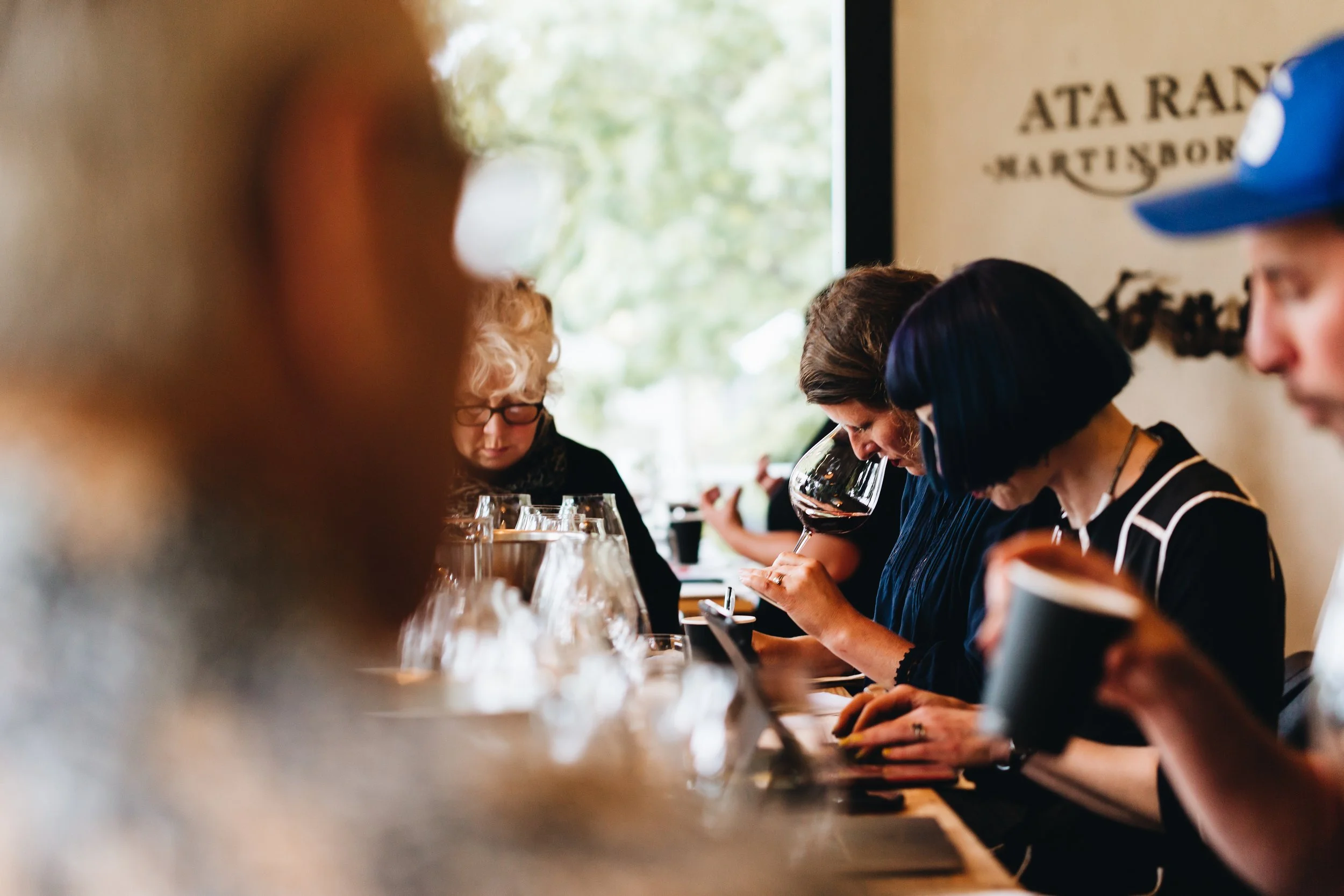Twenty Six Summers of Ata Rangi
To mark the opening of our new Tasting Room we had the pleasure of the company of invited wine writers, sommeliers and staff past and present, joining us for a once in a lifetime vertical tasting of Ata Rangi Pinot Noir. With a collection of magnums bought and cellared impeccably by a private customer we had the chance to retrospectively sample the seasons of Ata Rangi from 1994 through to 2019.
Wine writer, Mike Bennie penned jotted down his thoughts. Read Mike’s musings here. Another one of our guests was wine writer, John Saker. These are his notes as he meandered through our history with us.
ATA RANGI — REMEMBRANCE OF THINGS PAST
by John Saker
It was a liquid history lesson. Our texts were 25 magnums of Ata Rangi pinot noir, all under cork, representing every vintage from 1994 to 2019. The group that gathered at Ata Rangi on 17 November 2022 (a session that doubled as a baptism of the winery’s attractive new tasting room), gave itself to the study and enjoyment of these bottled portraits of 26 summers. Ata Rangi winemaker Helen Masters and kaumatua/founder Clive Paton were our tutors. For an afternoon, time seemed to collapse.
1994
I approached the this wine with anticipation. It was a shining star when first released, responsible for a lot of Ata Rangi’s early cred, and it kept giving pleasure for so long afterward. It was still beautiful and Musigny-like when I last tasted it 10 or so years ago. Now getting close to 30, it looked post-autumnal, all earth and umami, the acidity pushing up through the floor. And yet, as with most splendid wines, there were still echoes of the prettiness and glory that was.
1995
This year was another early wunderkind from a made-to-order growing season. It presented as a bigger, more strident version of the ’94, its fungal and umami notes carrying a distinct minerally edge. Despite its advanced development it ended well, lovely and long, as if to say “I’m not quite done yet.”
1996
A wine that has always had a ‘look at me’ demeanour is the 1996, though you wouldn’t think so to smell it this time round - very shy, hints of fig and sumac. But once in the gob, what a treat. Gently textured, it had the most wonderful curving shape, and amid the savoury development, some fruit sweetness still held. It finished with an attractive bitterness. Quite beautiful.
1997
From a cooler season, this wine looked a little old and crotchety. The acidity had a big say, flattening the shape, and there was a potent minerally, iodine complexion to the flavour profile, a touch of sweetness also evident. The finish was a little frayed.
1998
Up and down the country, the 1998 vintage proved instructive. A summer of drought had many in the wine industry thinking they were in heaven, but more than a few wines fell short of the high hopes. The Ata Rangi ’98 has always been a tannic tiger and that snarl was still there. The fruit (spiced dried fruit, a touch of sweet rose) was approaching the exit door. The lesson for Clive Paton from ’98 was ‘pick earlier’.
1999
The millennium’s final vintage provided floral perfume and plenty of red and dark fruit charm, some mushroomy development also happening. It was the product of a warm, dry vintage and from the get-go was a pretty wine with a lot of stuffing. That prettiness is still present, proudly so.
2000
A ravishing performance. It was fragrant, the fruit holding beautifully, an overlay of savoury complexity lending it soul. The passage across the palate was slow and luxurious. This wine was à point, the product of an outstanding vintage and still full of fun and class. I loved it.
2001
The 2001 vintage made it three good ‘uns in a line and the Ata Rangi style/personality/essence was by now under full sail. This was another accomplished wine with its sweet fruit entry, red fruit bias and tight acid/tannin lines. Its depth was noteworthy and it finished with the proverbial peacock’s tail.
2002
Settled autumn weather (not untypical for New Zealand) helped bail out the wet and worrisome 2002 growing season. This wine has always shown some reduction. It is far less pronounced now (the French like to say that reduction is the fruit of tomorrow), and there was newfound enjoyment for me in this wine. Red fruit and that Ata Rangi poise and delicacy were on full display. The finish was juicy and lingering.
2003
A vintage defined by an awful spring which saw drastically reduced yields still managed to produce a remarkable pinot. The 2003 was an intense wine, a core of fleshy dark sweet fruit with a saline, steely edge, framed by fine tannins.
2004
The 2004 was another great example of pinot’s ability to not only withstand, but also draw something, from adverse conditions. This was a rainy season (500ml across six weeks), but out of it came a boldly-structured wine with tension, energy and gorgeous fruit.
2005
Spring, once again, did not smile kindly, and the harvest was another low yield vintage. Small bunches and berries contributed to give this wine its darkness and intensity. That fruit still looked quite luscious and primary, with some sappy, green olive notes also in attendance.
2006
The Ata Rangi 2006 has long been a personal favourite of mine. It showed early promise and like many of us, was in no hurry to grow up. The issue of this magnum did not disappoint. In fact it was glorious – sweet red fruit to the fore, scroggin and savoury notes chiming in, energy and freshness in abundance. A delight.
2007
And so to the 2007, the pinot Helen Masters has called ‘Ata Rangi in leather’. That swagger is still there. There’s something of a coiled spring at its centre, a ball of dark fruit still exuding a quiet power, supported by structural elements that are bold and uncompromising. Full of energy and vigour.
2008
A smoky, savoury nose belied the joyous quality of the fruit, which was full of sweet allure, some autumnal notes, and carried by fresh acidity. The product of a dial-up vintage and it showed. Plenty of life left in this trooper.
2009
No wine has been as easy to get along with as the 09. It was as laid back as ever, a languid flow of fruit, sweet rose in character, the texture a gentle caress. Undemanding, always smiling and how can you not smile back?
2010
A summer that was mostly cool followed by an autumn of dreams authored terrific fruit. The Ata Rangi signature dried grass scent lifted the curtain on a frolic of pristine, exuberant fruit, red and dark. Long tannins enabled a fine, satisfying resolution.
2011
There had to be at least one. This magnum was corked, so we tasted the vintage from 750ml bottles. As it always has, this wine showed its two sides – an edgy, slightly reductive minerality mixing with graceful, light-dancing fruit. Beauty and the beast? More like Meads meets Dame Margot. It’s a distinctive wine that I get more pleasure from every time I taste it.
2012
There were challenges aplenty, Dubbed the ‘grey sun’ summer as so many days were overcast and cool. A credit to the Ata Rangi team then for the wine that was made that year. At this tasting it looked vibrant and airy: red berry, blood orange and white pepper characters, the fruit underpinned by a structural ease.
2013
Nothing unlucky about this ’13. It produced vintage conditions that answered most winegrowers’ prayers. ‘That’s corker!’ began my notes. Dense fruit, tautness, an elegant structure and a lovely, unhurried passage across the palate reminded me of why I love pinot so much. An Ata Rangi classic with many more years ahead of it.
2014
A golden run was in progress. The year was a little cooler overall than the year before but still a splendid vintage. Hay and dark fruit perfumes set the tone for a splashingly enjoyable wine, lifted by juicy acidity. It was full of energy and depth and the tannins were long and ripe. From around this time, the wines start to show more complexity in structure, the influence of older vines together with winemaker experience and confidence.
2015
What impressed me most about the 2015 – and a lot about it was impressive – was the mid-palate texture. It had a polished stillness that acted as a hesitation step, drawing out the palate. Its scents were playful and the fruit was so gorgeous, a gift that had come wrapped in fine tannins and acids. Stunningly good.
2016
“That’s amazing too!’ I gushed. It was a compact mouthful, with the tannins and acids tucked in tightly under the flamboyant fruit. Another textural triumph, it grew in the mouth and finessed its way to a lengthy finish.
2017
‘Enough of this clement weather,’ said Zeus (obviously out of the hearing of Bacchus). The 2017 vintage was challenging, with rain and cooler temperatures a feature of January and February. The wine showed remarkably well, all things considered. Red fruit notes were juxtaposed with a wild, brambly attitude and tight acidity. It finished lovely and long.
2018
There were several twists and turns to the 2018 growing year. The wine that resulted was a racy, pretty little number. It was red fruit-dominant, light in structure (the year was notable for low alcohol levels) and bristling with energy.
2019
From the moment this wine met my nostrils, I knew I was in excellent company. The trademark florals and straw aromatics, along with a whisper of church incense, were followed by a mouthful of pure pleasure. Sweet red berry notes, juicy and tight, framed by delicate, minerally tannins trod fine lines. Absolutely gorgeous, and an absolute keeper. (Winemaking aside: the ferment was 40% whole bunch).
Finally, the perfect one to end on, the Old Vine Abel 2019
The tasting finished with a tribute to the pinot noir clone which has been an Ata Rangi – and Martinborough – foundation stone. A magnum of Ata Rangi Old Vine Abel 2019 was opened and provided a foot-stomping encore. Layers of flavour – wild berry, dark tea, herbal twists – jumped out from a palate that had presence and authority. A singular, swashbuckling style.
“We are eccentric here, but we make wines we love,” Helen Masters said as part of her closing remarks. After which longtime Ata Rangi friend and adviser John Comerford, offered in his vote of thanks: “You should be very proud of what you’ve achieved here.”
Ka pai to that. So too are we all proud of them and their work. And as for that eccentricity, we love it to bits.
Thanks to John Saker for the notes.
















